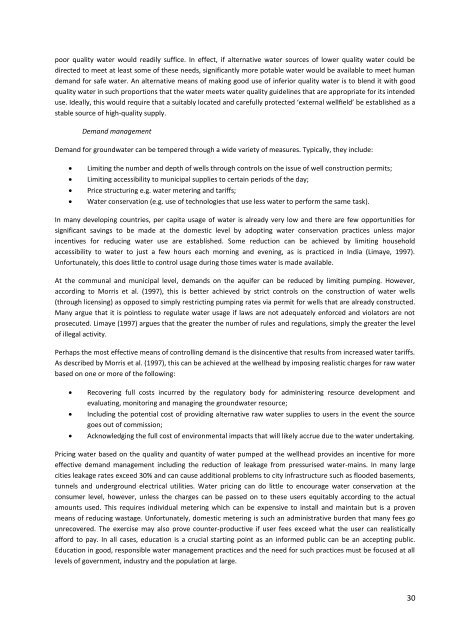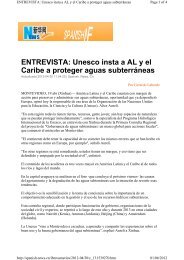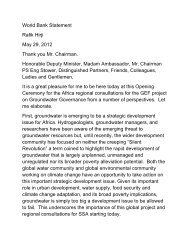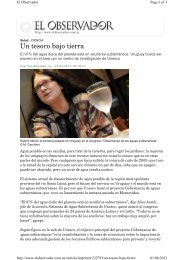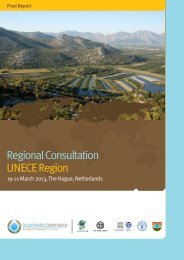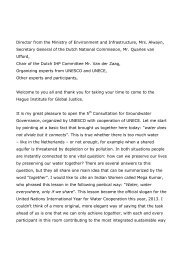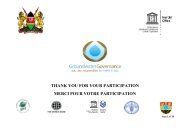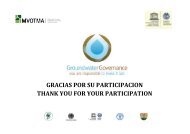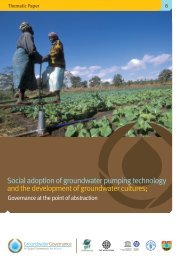poor quality water would readily suffice. In effect, if alternative water sources of lower quality water could bedirected to meet at least some of these needs, significantly more potable water would be available to meet humandemand for safe water. An alternative means of making good use of inferior quality water is to blend it with goodquality water in such proportions that the water meets water quality guidelines that are appropriate for its intendeduse. Ideally, this would require that a suitably located and carefully protected ‘external wellfield’ be established as astable source of high-quality supply.Demand managementDemand for groundwater can be tempered through a wide variety of measures. Typically, they include:Limiting the number and depth of wells through controls on the issue of well construction permits;Limiting accessibility to municipal supplies to certain periods of the day;Price structuring e.g. water metering and tariffs;Water conservation (e.g. use of technologies that use less water to perform the same task).In many developing countries, per capita usage of water is already very low and there are few opportunities forsignificant savings to be made at the domestic level by adopting water conservation practices unless majorincentives for reducing water use are established. Some reduction can be achieved by limiting householdaccessibility to water to just a few hours each morning and evening, as is practiced in India (Limaye, 1997).Unfortunately, this does little to control usage during those times water is made available.At the communal and municipal level, demands on the aquifer can be reduced by limiting pumping. However,according to Morris et al. (1997), this is better achieved by strict controls on the construction of water wells(through licensing) as opposed to simply restricting pumping rates via permit for wells that are already constructed.Many argue that it is pointless to regulate water usage if laws are not adequately enforced and violators are notprosecuted. Limaye (1997) argues that the greater the number of rules and regulations, simply the greater the levelof illegal activity.Perhaps the most effective means of controlling demand is the disincentive that results from increased water tariffs.As described by Morris et al. (1997), this can be achieved at the wellhead by imposing realistic charges for raw waterbased on one or more of the following:Recovering full costs incurred by the regulatory body for administering resource development andevaluating, monitoring and managing the groundwater resource;Including the potential cost of providing alternative raw water supplies to users in the event the sourcegoes out of commission;Acknowledging the full cost of environmental impacts that will likely accrue due to the water undertaking.Pricing water based on the quality and quantity of water pumped at the wellhead provides an incentive for moreeffective demand management including the reduction of leakage from pressurised water-mains. In many largecities leakage rates exceed 30% and can cause additional problems to city infrastructure such as flooded basements,tunnels and underground electrical utilities. Water pricing can do little to encourage water conservation at theconsumer level, however, unless the charges can be passed on to these users equitably according to the actualamounts used. This requires individual metering which can be expensive to install and maintain but is a provenmeans of reducing wastage. Unfortunately, domestic metering is such an administrative burden that many fees gounrecovered. The exercise may also prove counter-productive if user fees exceed what the user can realisticallyafford to pay. In all cases, education is a crucial starting point as an informed public can be an accepting public.Education in good, responsible water management practices and the need for such practices must be focused at alllevels of government, industry and the population at large.30
Efficient management of the resourceUltimately there are limits to which supply can be increased and demand reduced. The long-term sustainability ofgroundwater supplies for growing cities requires that groundwater be managed far more efficiently. This means thatwater quality impacts must be minimised and that available water reserves must be managed to maximise theirutility. Recognising that surface water is an important component of the urban water cycle and a critical watersource for most cities, significant additional management benefits can be obtained by optimising their combineddevelopment through conjunctive use (Paling, 1984). Conjunctive use recognises the interdependency between theground and surface water resources of a basin and ensures that maximum benefit is obtained by integrating groundand surface water resources into a single resource management plan. To date, unfortunately, most conjunctive useencountered in the developing world amounts to a “piecemeal coping strategy” (Foster et al., 2010b) in response toan urgent resource problem.According to Barber (1997), management of our groundwater systems should be underpinned by science. The roleof the scientist is to address perceived problems and develop solutions that can be used by resource managers.Management practice can then evolve by incorporating scientific developments into an overall strategy to achievebest-available practice. Fortunately, the science is well advanced and there a wealth of excellent ground and surfacewater modelling tools that can be used for:Quantifying the water budget;Performing vulnerability assessments and identifying “ZOC’s – zones of contribution” -areas around wellsmost in need of protection;Predicting groundwater travel times for contaminants in the system;Determining “optimal” pumping and water extraction rates, andTesting and evaluating alternative water management scenarios.Despite a critical lack of reliable data for urban areas, these models can greatly assist in the development ofmanagement programs and provide support for decision-making. “Assist” is the key word since the formulation ofappropriate management action plans is as much social as it is technical. It is a long-term process that demandssustained national and international political commitment, social consensus and substantial improvements in thetypes of data so essential for resolving complex aquifer flow dynamics and the patterns of socio-economic demandthat are placed upon the resource. Waiting for data, however, is not an excuse to delay action (Burke and Moench,2000).There is a strong school of thought that strategies for groundwater management are most effective when theyare developed in close co-operation with stakeholders, andfully acknowledge economic, social and political conditions.This philosophy equally applies to aquifer [water quality] protection plans that should form an integral componentof groundwater management. Traditionally, water projects in developing countries have been instituted using the“top down” management approach that rarely considers the interests and specific needs of the individual users, butsatisfies, at least in principle, the goals and aspirations of government officials, consultants and support agencies. Inthe poorest countries, the interests of stakeholders, including users within the local communities, are totallyignored. According to the principle of participatory management, first introduced at the 1992 Dublin InternationalConference on Water and the Environment, the development of water policy should adopt a participatory approachthat involves users, planners, and policy makers at all levels. Most importantly, the participatory approach wouldrequire that decisions be taken at the lowest appropriate level which, in practice, means the direct involvement oflocal and regional agencies representing community interests. All stakeholders must be satisfied that their needs arebeing met as ultimately, workable solutions will not be forthcoming without the full commitment and co-operationof all levels of government, industry and the population at large. In effect, current problems with urban31
- Page 3 and 4: GROUNDWATER GOVERNANCE:A Global Fra
- Page 5 and 6: List of FiguresFigure 1 Global and
- Page 7 and 8: and Karachi (Pakistan) with rates w
- Page 9 and 10: increased risk to livelihoods from
- Page 11 and 12: Understanding and accounting for th
- Page 13 and 14: through a series of distinct stages
- Page 15 and 16: Despite the enormity of the urban g
- Page 17 and 18: viability is an additional problem.
- Page 19 and 20: especially where local aquifers are
- Page 21 and 22: Clearly, solutions are available to
- Page 23 and 24: 2) the State of Mexico, which suppl
- Page 25 and 26: easons: it would enable these costs
- Page 27 and 28: have developed and implemented stra
- Page 29 and 30: Domestic and low-demand commercial
- Page 31: 4 Groundwater Governance and Opport
- Page 35 and 36: understanding of the resource setti
- Page 37 and 38: to the problem that seeks to make p
- Page 39 and 40: 2) A carefully conceived program, w
- Page 41 and 42: domestic sewage, while in rural are
- Page 43 and 44: production (largely controlled by n
- Page 45 and 46: FOSTER, S., CHILTON, J., MOENCH, M.
- Page 47: THEESFELD, I. 2010. Institutional c


